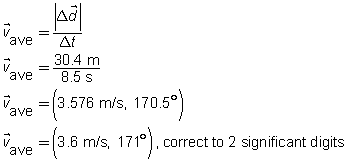Module 1—Motion
Average Velocity Versus Average Speed

© Dennis Sabo/Dreamstime
When you are travelling in a vehicle, you experience a change in position. The rate at which you change position defines the vector quantity velocity.
Do not confuse velocity with speed. For example, if two cars are racing around a circular track, they can have a very large speed and a very low velocity all at the same time. In addition, they can be constantly changing velocity without changing speed. How can this be?
 Watch and Listen
Watch and Listen
Watch the animation titled Velocity. Look for the differences between speed and velocity.
 Self-Check
Self-Check
SC 7. What differences between speed and velocity did you notice?
 Self-Check Answer
Self-Check Answer
SC 7. Velocity has a direction, and speed doesn’t. Velocity is displacement divided by time, and speed is distance divided by time. Speed is a larger number than velocity.
 Lesson 2 Lab: Velocity
Lesson 2 Lab: Velocity
Introduction
The simulation used for this lab finds the average velocity and average speed for a ball as the ball is moved from one point to another.
This simulation lets you study the concepts of velocity and speed. You can learn more about the simulation and how to use it by reading the Show Me found at the top of the simulation screen. You will still have to use the correct notation that you have been taught.
Problem
How is the more familiar scalar quantity speed different from the vector quantity velocity?
Open the Average Velocity simulation; then continue with the procedure.
Procedure
LAB 7. Familiarize yourself with the simulation by completing the following steps:
-
Open the Average Velocity simulation.
-
Reset (
 ) the simulation.
) the simulation.
-
Turn on the gridlines (
 ).
).
-
Position (
 ) the ball at (x, y)i = (10.0, –15.0) m.
) the ball at (x, y)i = (10.0, –15.0) m.
-
Drag the ball along any curved path to somewhere near
(x, y)f = (–20.0, –10.0) m.
Observations
Remember from the previous simulation that these authors use s for distance, but we use Δd. The authors also use ![]() for displacement, but we use
for displacement, but we use ![]() . The magnitude of the displacement should be indicated as
. The magnitude of the displacement should be indicated as ![]() .
.
In Figure 1, the following values are included in the display:
-
distance travelled: Δd = 36.6 m
-
displacement in the Cartesian system
 = (
= ( , θ)
, θ)
 = (30.4 m, 170.5°)
= (30.4 m, 170.5°)
-
elapsed time: Δt = 8.5 s

Figure 1
Note that the time figure given is based on how quickly the ball was moved from position 1 to position 2. Your time value should be different from that shown in Figure 1.
Figure 1 also indicates the average speed and average velocity expressed in the Cartesian system.
Average Velocity Versus Average Speed
Average velocity is defined as the ratio of displacement divided by time elapsed. It has both magnitude and direction.
Average speed is defined as the ratio of distance travelled divided by time elapsed. It does not have an expression of direction.
Quantity |
Equation |
SI Unit |
average velocity |
|
m/s, direction |
average speed |
|
m/s |
The following two example problems illustrate how to calculate average speed and average velocity and will illustrate the difference between the two quantities.
Example Problem 1
Given the distance and time data, what is the average speed?

The applet doesn’t round its values. It just chops off any extra digits.
Example Problem 2
Given the displacement and time data, what is the average velocity?
Note that to divide a vector (![]() ) by a scalar (Δt), you divide its magnitude
) by a scalar (Δt), you divide its magnitude ![]() by the scalar and do not change the angle.
by the scalar and do not change the angle.

Note the difference in magnitude between the average velocity and average speed.
-
magnitude of average velocity
 = 3.6 m/s
= 3.6 m/s -
average speed vave = 4.3 m/s
The two values are not equal! This is why the magnitude of the average velocity cannot be denoted by the symbol vave.
Analysis
 Module 1: Lesson 2 Assignment
Module 1: Lesson 2 Assignment
Remember to submit the answer to LAB 8 to your teacher as part of your Module 1: Lesson 2 Assignment.
LAB 8. Calculate the average speed and the average velocity for a ball that is moved according to the following instructions.
-
Reset (
 ) the simulation, and position (
) the simulation, and position ( ) the ball at
) the ball at
(x, y)i = (10.0, –5.0) m. -
Drag the ball along any curved path to somewhere near
(x, y)f = (–20.0, –10.0) m.
-
Show the average speed calculations.
-
Show the average velocity calculations.
LAB 9. Using a procedure similar to LAB 2, calculate the average speed and the average velocity for a ball that is moved from (x, y)i = (0.0, –12.0) m to
(x, y)f = (5.0, –16.0) m.
- Show the average speed calculations.
- Show the average velocity calculations.
- Do your answers approximately correspond to the values given in the simulation?
 Module 1: Lesson 2 Assignment
Module 1: Lesson 2 Assignment
Remember to submit the answer to LAB 10 to your teacher as part of your Module 1: Lesson 2 Assignment.
LAB 10. Why is the average speed always greater than the magnitude of the average velocity?
LAB 11. Could there ever be a situation in which it is the other way around? Explain.
Lab Summary
How is the more familiar scalar quantity speed different from the vector quantity velocity?
The familiar quantity of speed has only a magnitude determined by the change in distance divided by the change in time. The vector quantity velocity has a direction and a magnitude which is determined by the change in position (displacement) divided by the change in time.
 Self-Check
Self-Check
SC 8. On page 75 of your textbook, complete question 3 of “2.1 Check and Reflect.”
SC 9. On page 75 of your textbook, complete question 7 of “2.1 Check and Reflect.”
SC 10. On page 75 of your textbook, complete question 9 of “2.1 Check and Reflect.”
 Self-Check Answers
Self-Check Answers
SC 8.
Given
scale is 5.0 m [S] = 6.0 cm
Required
the length of a scale vector diagram of 20 m [S]
Analysis and Solution
The length of the vector scale diagram will be proportional to the scale. Set up a proportionality ratio such that the m units cancel and the cm remain.
![]()
Paraphrase
The length of the scale vector diagram is 24 cm.
SC 9.
Given
Initial segment of journey is 500 km [N].
Final displacement is 50 km [N].
Three southward segments are each 50 km longer than the previous one.
Required
the length of each displacement south
Analysis and Solution
Choose north as the positive direction.
Let the first displacement be ![]() km [S]. Then the next one is (
km [S]. Then the next one is (![]() + 50 ) km [S], and the third displacement is (
+ 50 ) km [S], and the third displacement is (![]() + 100 ) km [S]. The sum of the displacements is given by the following equation:
+ 100 ) km [S]. The sum of the displacements is given by the following equation:
![]()
Solve the equation.

Paraphrase
The three displacements are 100 km [S], 150 km [S], and 200 km [S].
SC 10.
Given
initial height = 10.0 m
height of bounces = 8.0 m, 4.0 m, and 2.0 m
Required
- the distance the ball travels (Δd)
- the displacement of the ball (
 )
)
Analysis and Solution
Choose the positive direction to be upwards. Distance is the sum of the magnitudes of the downward journeys and upward bounces. Displacement is measured from the initial position to the final position.

Paraphrase
The distance the ball travels is 36.0 m.
The displacement of the ball is 8.0 m [downwards].